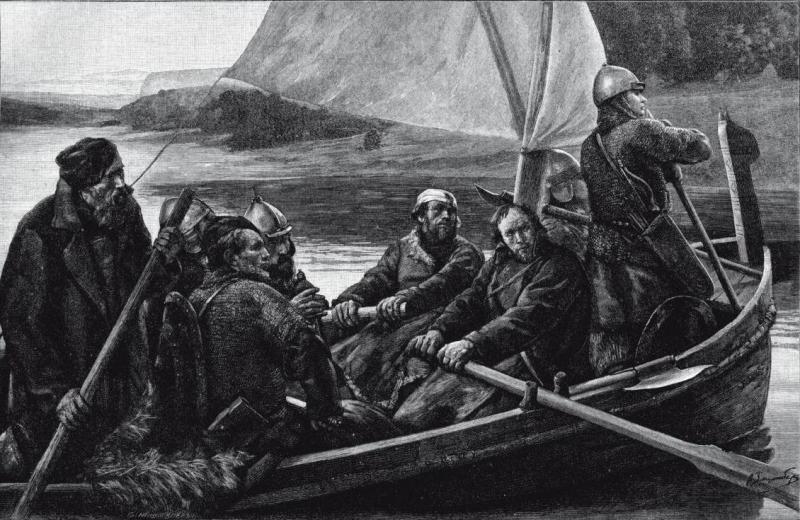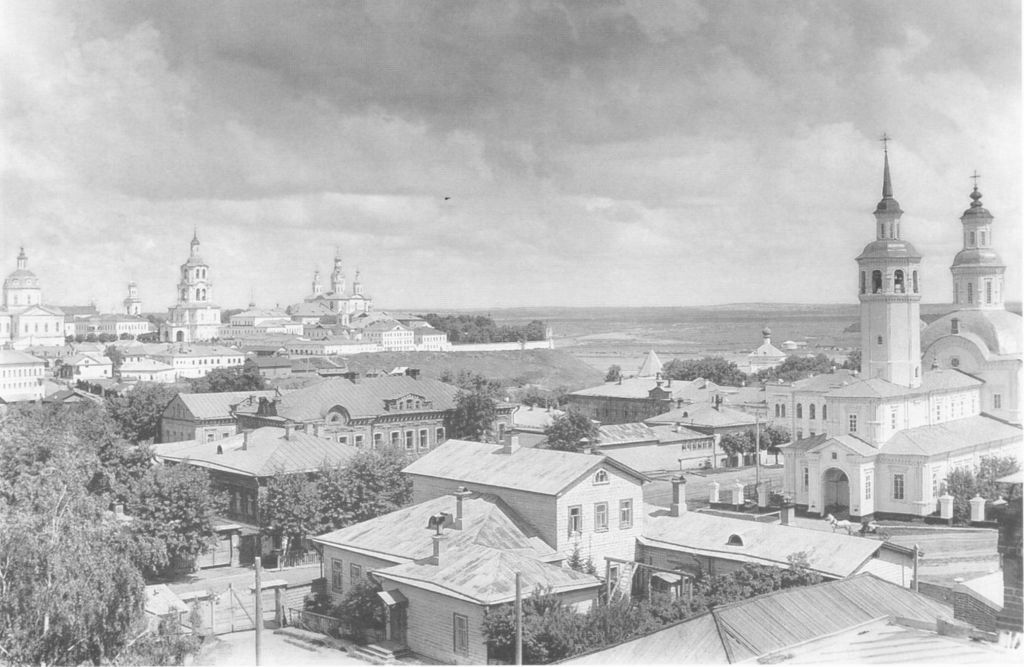|
Chumbylat
Chumbylat ( Mari: Чумбылат, Кугу Курык Кугыза) was a 12th-century ruler of the northern Mari city and country of Kokshar, nowadays known as Kotel'nich, in Russia. He came from a noble dynasty of rulers of Kokshar and was related to the previous ruler, Kugyrak. Chumbylat united the Mari people and brought them to the land they live in now. He ordered the building of many fortresses and his country reached from Kotel'nich to Nizhny Novgorod. The Mari people considered Chumbylat their king. During his reign, many religious traditions developed that stayed unchanged for centuries. Before going to battle, Chumbylat and his companions prayed in the sacred groves accompanied by a zither ensemble. After that they sang inspirational songs and went into battle. In 1181 Kotel'nich was captured for the first time by the Novgorod uškuiniks. Chumbylat built a new capital Kukarka Sovetsk (russian: Сове́тск), formerly Kukarka (russian: Кука́рка; chm, К ... [...More Info...] [...Related Items...] OR: [Wikipedia] [Google] [Baidu] |
Mari People
The Mari ( chm, мари; russian: марийцы, mariytsy) are a Finnic people, who have traditionally lived along the Volga and Kama rivers in Russia. Almost half of Maris today live in the Mari El republic, with significant populations in the Bashkortostan and Tatarstan republics. In the past, the Mari have also been known as the Cheremisa or the Cheremis people in Russian and the Çirmeş in Tatar. Name The ethnic name ''mari'' derives from the Proto-Indo-Iranian root *''márya''-, meaning 'human', literally 'mortal, one who has to die', which indicates early contacts between Finno-Ugric and Indo-Iranian languages. History Early history Some scholars have proposed that two tribes mentioned by the Gothic writer Jordanes in his ''Getica'' among the peoples in the realm of Gothic king Ermanaric in the fourth century CE can be equated with the Mari people. However, the identification of the ''Imniscaris'' (or ''Sremniscans'') with "Cheremis", and ''Merens'' with "Mari" i ... [...More Info...] [...Related Items...] OR: [Wikipedia] [Google] [Baidu] |
Sovetsk, Kirov Oblast
Sovetsk (russian: Сове́тск), formerly Kukarka (russian: Кука́рка; chm, Кукарка), is a town and the administrative center of Sovetsky District in Kirov Oblast, Russia. Population: Etymology The origins of the name "Kukarka" are uncertain. It may derive from Mari words ''kü'' (stone) and ''karman'' (fortress) or from ''kugyrak'' (great). Attempts have been made to trace it to either Udmurt (''kar'' "town") or Turkic (''kukar'' "burned-away forest"). It is not related to the Russian word "" (''kukharka'', "female cook"). History In the 12th century, it was a capital of the local principality of Chumbylat, a renowned Mari leader and warrior. Kukarka was occupied in 1594 by Russians during colonization of Mari land. Later it was a '' sloboda'' in Vyatka Governorate of the Russian Empire. It was granted urban-type settlement status in 1918. Town status was granted to it in 1937, at which time its name was changed.Е. М. Поспелов. "Геогра ... [...More Info...] [...Related Items...] OR: [Wikipedia] [Google] [Baidu] |
Mari Language
The Mari language (Mari: , ''marij jylme''; russian: марийский язык, ''mariyskiy yazyk''), formerly known as the Cheremiss language, spoken by approximately 400,000 people, belongs to the Uralic language family. It is spoken primarily in the Mari Republic (Mari: , ''Marij El'', i.e., 'Mari land') of the Russian Federation as well as in the area along the Vyatka river basin and eastwards to the Urals. Mari speakers, known as the Mari, are found also in the Tatarstan, Bashkortostan, Udmurtia, and Perm regions. Mari is the titular and official language of its republic, alongside Russian. The Mari language today has three standard forms: Hill Mari, Northwestern Mari, and Meadow Mari. The latter is predominant and spans the continuum Meadow Mari to Eastern Mari from the Republic into the Ural dialects of Bashkortostan, Sverdlovsk Oblast and Udmurtia), whereas the former, Hill Mari, shares a stronger affiliation with the Northwestern dialect (spoken in the Nizhny Novgo ... [...More Info...] [...Related Items...] OR: [Wikipedia] [Google] [Baidu] |
Kotelnich
Kotelnich (russian: Коте́льнич; chm, Кäкшäр) is a river port town in Kirov Oblast, Russia, located on the right bank of the Vyatka River near its confluence with the Moloma, along the route of the Trans-Siberian Railway, southwest of Kirov. Population: History The locality of Koksharov () was first mentioned in 1143 as a Mari town. In 1182, it was occupied by Russians and renamed Kotelnich, from the word ''kotel'' (now ''kotlovina''), meaning "hollow", "depression".Е. М. Поспелов. "Географические названия мира". Москва, 1998, p. 218. Town status was granted to it in 1780. It became one of the main settlements of the Vyatka Land. The city of Kotelnich is well known all over Russia and in some foreign countries due to location of ancient fossil vertebrates – Pareiasaurus. Pareiasaurus – is a large reptile with spurs in the buccal region of the skull. These animals grew to about 3 meters long and inhabited Eur ... [...More Info...] [...Related Items...] OR: [Wikipedia] [Google] [Baidu] |
Nizhny Novgorod
Nizhny Novgorod ( ; rus, links=no, Нижний Новгород, a=Ru-Nizhny Novgorod.ogg, p=ˈnʲiʐnʲɪj ˈnovɡərət ), colloquially shortened to Nizhny, from the 13th to the 17th century Novgorod of the Lower Land, formerly known as Gorky (, ; 1932–1990), is the administrative centre of Nizhny Novgorod Oblast and the Volga Federal District. The city is located at the confluence of the Oka and the Volga rivers in Central Russia, with a population of over 1.2 million residents, up to roughly 1.7 million residents in the urban agglomeration. Nizhny Novgorod is the sixth-largest city in Russia, the second-most populous city on the Volga, as well as the Volga Federal District. It is an important economic, transportation, scientific, educational and cultural center in Russia and the vast Volga-Vyatka economic region, and is the main center of river tourism in Russia. In the historic part of the city there are many universities, theaters, museums and churches. The city w ... [...More Info...] [...Related Items...] OR: [Wikipedia] [Google] [Baidu] |
Ushkuiniks
Ushkuyniks (russian: ушкуйники), also ushkuiniks were medieval Novgorodian pirates which operated along the Volga River, the eastern part of Scandinavia, and north of the Ural mountains in 12th-15th century. Some historians see them as a continuation of Viking traditions of ancient Rus' people. Etymology The word is derived from the (russian: ушкуй), the type of ship they used. These ships could be easily transported over portages between watersheds. The word likely derives either from Oskuya river, or from Old Veps “*uškoi̯” (small boat). History Novgorodians took part in the Tsargrad expeditions of the 10th century and other raids on Byzantine Empire, mounted pillaging raids to Finland since 12th century (see Swedish–Novgorodian Wars),including seizing its capital - Turku. Ushkuyniks first appear in the historical record as an organized force in the 1320s. Arranged in squadrons which could number several thousand, Ushkuyniks enjoyed the patronag ... [...More Info...] [...Related Items...] OR: [Wikipedia] [Google] [Baidu] |
Kirov, Kirov Oblast
Kirov ( rus, Ки́ров, p=ˈkʲirəf, a=Ru-Киров.ogg) is the largest city and administrative center of Kirov Oblast, Russia. It is located on the Vyatka River in European Russia, 896 km northeast of Moscow. Its population was 518,348 in 2020. Kirov is a historical, cultural, industrial, and scientific center of Priural'e (territory on the west side of the Ural Mountains); place of origin for Dymkovo toys; the most eastern city founded during the times of Kievan Rus'. The city also had the names of Khlynov (, from 1457 to 1780), and Vyatka (, until 1934). History Principality and republic The native Slavic tribe of Central Russia and Volga regions, the Vyatichis (also called Viatichi), mixed here with the Novgorod Slavs, Novgorodian Slovenes and Finno-Ugric languages, Finno-Ugric people. According to the medieval chronicles the first Russian settlements in the area appeared in 12th century. Kirov itself was first mentioned (as Vyatka) for the first time i ... [...More Info...] [...Related Items...] OR: [Wikipedia] [Google] [Baidu] |



